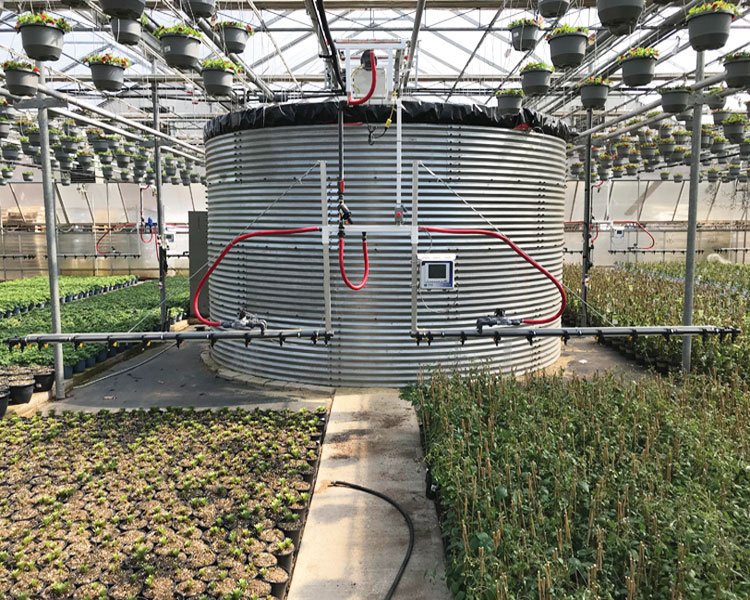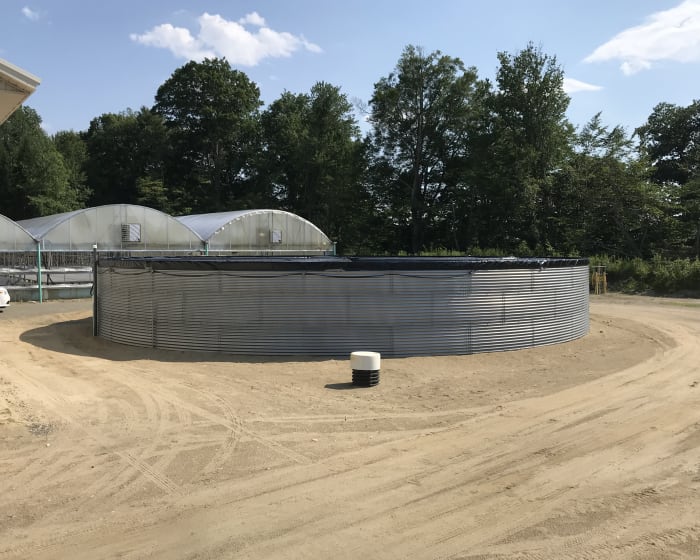

Top Water Treatment and Water Storage Solutions
Efficient water management is critical for greenhouse growers, ensuring that plants receive adequate hydration while optimizing resources, reducing waste, and controlling costs. Below are some of the best methods for greenhouse water storage.
-
Rainwater Harvesting Systems
Rainwater harvesting involves capturing and storing rainwater that falls on your greenhouse or facility, providing an eco-friendly and sustainable water source. This system reduces reliance on municipal water and helps lower utility costs.
Benefits:
- Cost-effective: Utilizing rainwater minimizes dependence on external water sources, potentially lowering water bills.
- Reduces reliance on municipal water sources: It provides a free and renewable water supply, which can help buffer against water restrictions or shortages.
- Environmentally friendly: Harvesting rainwater reduces strain on local water supplies, promotes sustainability, and conserves groundwater.
Components:
- Gutters and downspouts: Collect rainwater from roofs and direct it to storage.
- Filtration systems: Ensure that water is purified and safe for use by removing debris, dirt, and other contaminants.
- Storage tanks: Safely hold the collected rainwater until it is needed for irrigation or other uses.
Things to Consider:
- Maintenance: Regularly clean gutters, downspouts, and filters to prevent blockages and contamination that could harm plants.
- Water quality: Ensure that the filtration system is properly maintained to provide clean water for irrigation.
-
Water Tanks
Water tanks are one of the most common water storage methods for greenhouses. Available in various sizes and materials, they are versatile and customizable based on the needs of the greenhouse and its water consumption.
Types:
- Above-ground tanks: Easier to install and maintain but may need extra insulation in colder climates.
- Underground tanks: Ideal for larger storage volumes and space-saving, but installation is more complex and expensive.
Materials:
- Plastic (polyethylene): Lightweight, affordable, and durable; resistant to corrosion.
- Metal (galvanized steel): Sturdy, durable, and often more resistant to physical damage.
- Fiberglass: Lightweight, corrosion-resistant, and durable; ideal for harsh environments.
- Concrete: Extremely durable and long-lasting. Poured in place to any size.
Benefits:
- Easy installation: Can be quickly set up to store large volumes of water based on the greenhouse’s needs.
- Various sizes are available: Tailored to fit different scales of operations, from small greenhouses to industrial-sized farms.
- Relatively low cost: Flexible pricing options depending on size, material, and installation.
Things to Consider:
- Freezing temperatures: Above-ground tanks may need insulation to prevent freezing in cold climates, which could damage both the tank and its contents.
- Regular maintenance: Tanks should be periodically checked for leaks, algae build-up, or other issues.
-
Ponds and Reservoirs
For larger greenhouses or agricultural operations, ponds and reservoirs can be natural or constructed features that provide significant water storage capacity. These systems can store water from rain, streams, or wells and can be used to supply irrigation needs throughout the growing season.
Benefits:
- Large storage capacity: Capable of storing large quantities of water, which is beneficial for large-scale operations.
- Aesthetic and functional: Can be integrated into the natural landscape, serving both a practical function and contributing to the visual appeal of the greenhouse surroundings.
Things to Consider:
- Space requirements: Ponds and reservoirs require substantial space, making them less suitable for small greenhouses or urban operations.
- Lining and leakage prevention: Ensure that ponds are properly lined to prevent water loss through seepage.
- Maintenance: Regular upkeep is required to manage algae growth, sediment accumulation, and potential contamination from surrounding areas.
-
Integrated Water Management Systems
Integrated water management systems combine multiple water storage and treatment methods, such as rainwater harvesting, tanks, and automation, to create a highly efficient and sustainable water storage solution.
Components:
- Combination of tanks and rainwater harvesting: Multiple storage systems are often combined to maximize water efficiency and reliability.
- Automated control systems: Use sensors and software to manage water usage, ensuring that the right amount of water is used for irrigation at the right times.
Benefits:
- Optimizes water use: Systems are designed to minimize waste and ensure that water is used as efficiently as possible.
- Reduces water waste: Automated systems help prevent over-watering and ensure that no water is wasted.
- Tailored to specific greenhouse needs: Systems can be customized based on the size of the operation, climate, and water demands.
Things to Consider:
- Higher initial cost: The setup of an integrated system can be expensive due to the complexity and technology involved.
- Regular monitoring and maintenance: These systems require consistent upkeep to ensure they function correctly and continue to optimize water use.
-
Reclaimed Water Systems
Reclaimed water systems recycle used water, treating it to make it safe for reuse in irrigation. These systems help conserve water, reduce waste, and contribute to a sustainable greenhouse operation.
Benefits:
- Reduces water waste: By reusing water, growers can minimize the amount of freshwater needed for irrigation.
- Environmentally sustainable: Reclaiming water helps reduce strain on local water supplies and promotes a circular water economy.
Components:
- Filtration and purification systems: These systems filter and purify used water, removing harmful contaminants before it is reused in irrigation.
Things to Consider:
- Regulatory compliance: Reclaimed water must meet specific quality standards and regulations to be safely reused, which may vary by region.
- Ongoing maintenance: Regular cleaning and maintenance of filtration systems are essential to ensure water quality and prevent clogging or breakdowns.
Conclusion
AdeptAg recognizes the importance of efficient water management in modern greenhouse and CEA operations. With a range of irrigation solutions available, from rainwater harvesting and water tanks to advanced integrated water management systems, we help growers optimize water usage, reduce costs, and minimize environmental impact. Whether you’re seeking solutions for small-scale greenhouses or large commercial operations, AdeptAg offers tailored irrigation systems that meet your specific needs. AdeptAg can help you find the perfect solution for your water management challenges today.
For more information, please contact your AdeptAg sales representative.